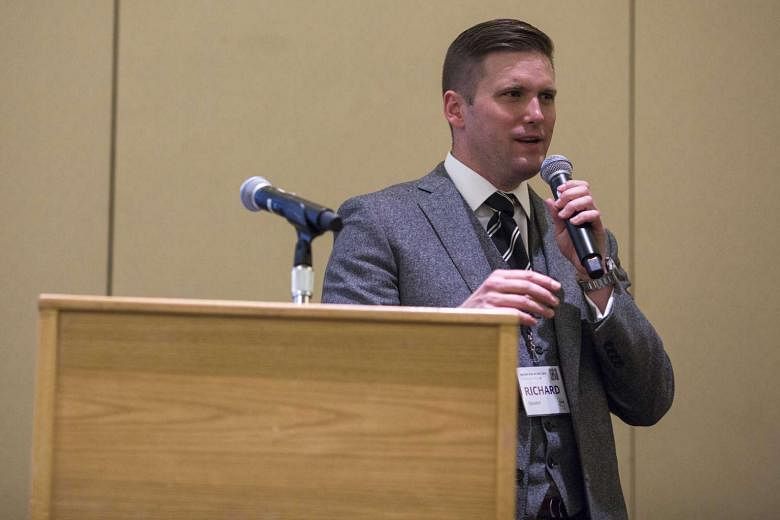WASHINGTON - The alt-right burst onto the US political scene following Mr Donald Trump's election victory, alarming many in the United States and putting pressure on the Republican President-elect to distance himself from it.
The alternative-right, or alt-right, movement has emerged as a counterpoint to mainstream conservatism and it believes that national identity should be built around white people.
Here are six things to know about the movement:
1. It has no formal structure and attracts different supporters, but its main focus is white identity
It is a loosely organised group made up of different types of people with different ideas, including white nationalists, white supremacists, neo-Nazis and anti-Semites. Its ideology is drawn from various places: the traditional far right, white supremacist theory and even rejection of free market economics.
Its main focus is white identity and to preserve Western civilisation, according to the Southern Poverty Law Centre, an organisation that monitors anti-hate groups. It says the alt-right movement believes that white identity is being threatened by multi-culturalism, politically correct thinking and the civil rights movement.
2. It has similarities with white supremacy, but there are differences between them too
It believes that national identity should be built around white ethnicity, and white people should maintain both demographic majority and dominance of the nation's culture and public life. So, like the white supremacists, the alt-right places the interests of white people over those of other racial groups. They both believe that racial discrimination should be incorporated into law and policy.
But white supremacy is based on a racist belief that white people are innately superior to people of other races. The alt-right, on the other hand, believes in maintaining political and economic dominance, not just a numerical majority or cultural hegemony.
3. It has more appeal than previous white nationalist movements
Earlier movements like neo-Nazi leader William Pierce's National Alliance, the National Socialist Movement and the Ku Klux Klan did not have much of an appeal to anyone who was not at least somewhat anti-social. The alt-right, in contrast, has been able to successfully brand itself as an edgy, fun and ironic movement that takes pleasure in needling both liberals and conservatives. It is also seen as tongue-in-cheek and rebellious as opposed to just being motivated by hatred.
4. A typical alt-right person is white male millennial
A typical alt-right person is a male, white millennial; probably has a college degree or is in college; is secular and perhaps atheist; and is not interested in the conservative movement at all. This is according to political scientist George Hawley from the University of Alabama, who has been interviewing people in the movement and is writing a book about it. He said a typical alt-right person has no interest in the basic principles that define the mainstream right: traditional family values, limited government intervention in the economy and a hawkish foreign policy.
5. They believe they complete Donald Trump
One of the movement's most prominent informal leaders, Mr Richard Spencer, told a conference on Saturday (Nov 19) that "the alt-right can, as an intellectual vanguard, complete Trump". At the end of his speech, he shouted "Hail Trump, hail our people, hail victory!", which was reminiscent of the German "Heil Hitler!". Some people in the crowd clapped wildly, cheered and gave the Nazi salute.
Dr Nicole Hemmer, an expert on the far-right movement at the University of Virginia, said "the alt-right sees his (Trump's) election as a big win for them and as an elevation to the mainstream of American life". She said: "They won't become the main mainstream of American life, but it definitely makes them more visible and it gives them a sense of greater political power."
The President-elect himself has disavowed the group, saying on Tuesday (Nov 22): "It's not a group I want to energise, and if they are energised, I want to look into it and find out why."
6. Majority of its supporters act online via social media.
The movement is flourishing online, where it has used social media to spread its cause, operating largely unchecked - for a long time - by social media giants Twitter and Facebook. But Twitter recently suspended alt-right's accounts, including that of Mr Spencer, after the social media service said it would crack down on hate speech.
The alt-right has also found a voice in Breitbart News, a conspiracy-mongering website that publish racist, anti-Semitic and misogynist articles. It was run by Mr Stephen Bannon from March 2012 to August this year, before he left to join Mr Trump as chief executive of his presidential campaign. Mr Bannon has been appointed to the key role of chief strategist in the Trump administration.
SOURCE: NEW YORK TIMES, WASHINGTON POST, USA TODAY, REUTERS, AFP

